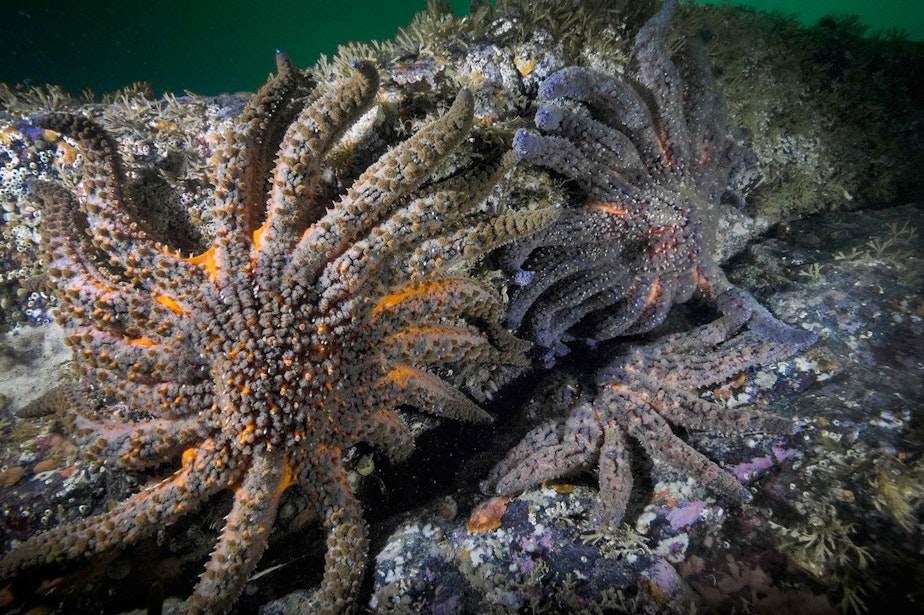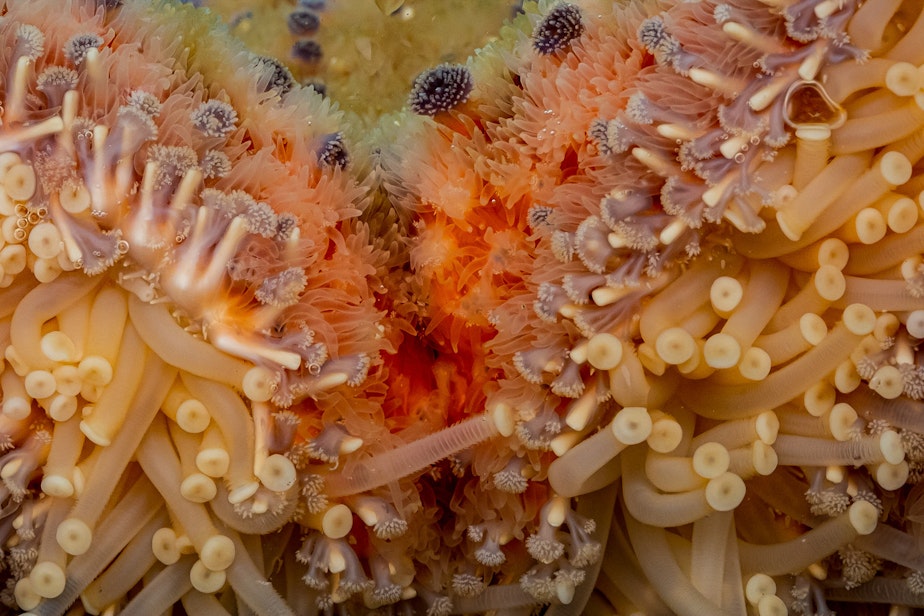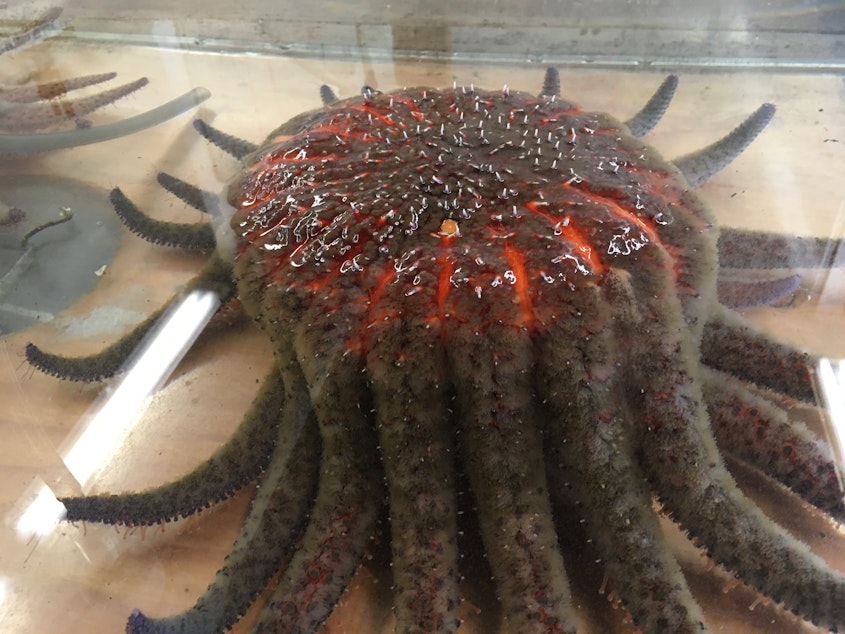Scientists race to rescue world’s fastest sea star from oblivion

Scientists are racing to revive a critically endangered species that has succumbed to a mysterious underwater pandemic up and down the West Coast.
The species is the sunflower star, a pizza-sized predator that can have two dozen arms. Since 2013, a wasting disease of unknown origin has turned some 5 billion sunflower stars, or 90% of the global population, into goo.
“I think there’s a pretty high potential for extinction of this species, particularly in certain geographies, so we’re all moving as quickly as we can,” Nature Conservancy scientist Walter Heady said during a panel on sunflower stars Wednesday at the Salish Sea Ecosystem Conference.
While some other species hit by the wasting disease have shown signs of recovery, sunflower stars have not.
Scientists say a few scattered fjords in British Columbia and Washington state still harbor remnant pockets of decent-sized populations of the endangered species. Recreational divers report finding patches of adult sunflower stars on the eastern shoreline of Whidbey Island.
Researchers are working to find what’s causing the wasting disease, why it kills some stars but not others, and how to help survivors of the the world’s worst underwater pandemic bounce back more quickly.
Sponsored
Gliding along on thousands of tiny tube feet beneath its two dozen arms, the sunflower star is the world’s fastest sea star and a dominant predator on seafloors along North America’s West Coast. But it has been unable to outrun the virus or bacterium or whatever is behind the wasting syndrome that has attacked 20 species.
“It's always kind of blown my mind, honestly, that this disease was so broad, across so many different sea stars,” University of Washington biologist Jason Hodin said. “Maybe that doesn't seem like such a big deal to some of you, but that's equivalent to saying that a disease hits all different mammals that we know of.”
Biomedical researchers identified the virus behind humanity’s Covid-19 pandemic and sequenced its genome within weeks of its initial December 2019 outbreak in Wuhan, China.
It has been a different story for this underwater pandemic.
“It's coming on 10 years after we first saw this wasting outbreak, and we still don't know what the disease is,” Hodin said.
Sponsored
Researchers say until recently, very little was known about what microbes or viruses sea stars might harbor.
“When you're working in a system where you don't know what's normal, it is a lot harder to find something that is new,” said biologist Alyssa-Lois Gehman of British Columbia’s Hakai Institute.
“There is a possibility that we never discover or understand what is the causative agent of sea star wasting,” said ecologist Lauren Schiebelhut of the University of California, Merced. “We obviously really hope that is not the case.”
Schiebelhut has found genetic differences between healthy sea stars and diseased ones in the wild. She said pinpointing those differences could help efforts to breed disease-resistant stars—even without identifying the cause of the disease.

Sponsored
Even in pre-underwater-pandemic times, studying sunflower stars was challenging. In the lab, researchers wear gloves and carry the big stars upside down so their many tube feet don’t attach to human arms.
“These animals are so strong that it can be difficult to get them off if they decide to attach, particularly without harming them,” Gehman said.
“They have lots of interesting structures on their skin that can jab and grab predators, competitors or my arm hairs,” Gehman said.

Sponsored
The mass die-off of sea stars further complicated the work, from biosecurity measures to the supply of lab animals drying up.
Gehman has been hunting for the cause of the disease by injecting healthy sunflower stars with tissue from diseased stars.
“For a while we were unable to run experiments because we couldn’t get access to animals,” Gehman said.
With an invisible killer stalking sunflower stars, researchers have had to take further precautions to keep stars healthy, including separating the gregarious animals.
Sponsored
“They were very touchy-feely with one another, and that could be not a very good thing for transmitted disease,” Hodin said.
Like Covid-19 among humans, the wasting disease can be spread by individuals who don’t have symptoms. And it kills fast: within two to four days.
Sponsored
In 2020, the International Union for Conservation of Nature declared the sunflower stars critically endangered, the first sea star to gain that unfortunate status.
Neither the U.S. nor the Canadian government has given endangered species protections to the sunflower star.
The nonprofit Center for Biological Diversity petitioned the National Marine Fisheries Service in August to list the sunflower star, Pycnopodia helianthoides, as an endangered species. The federal agency launched a review in December to determine whether the species deserves an endangered listing.
Even without a government mandate, an international working group has been putting together a “roadmap to recovery” for the species to coordinate research efforts and prepare to expand the number of captive-rearing facilities.
“We need to transition from only studying and documenting to acting,” Schiebelhut said. “Pycnopodia may not have the time for us to delay any longer.”
Scientists speaking at the Salish Sea Ecosystem Conference wouldn’t estimate how long it might take before all the pieces are in place to start reintroducing the critically endangered species to the sea on a large scale.
“That’s something our team wrestles with on a daily basis,” Heady said. “It’s that mix of being really careful and yet setting us up to be as quick as possible.”
Researchers at the University of Washington’s Friday Harbor Laboratories currently have 900 juvenile sunflower stars growing in tanks. The two-year-olds are about the size of an outstretched human hand. Hodin said he hopes to have enough full-size adults by next year to put some of them in undersea cages off San Juan Island for divers to monitor how the lab-raised animals fare in the wild.
Marine biologists say bringing the big stars back could help all sorts of ocean life, since sunflower stars prey on sea urchins. With fewer predators around in recent years, urchins have been chewing their way through the kelp forests that many species rely on.
From observing them in the lab, Hodin said, scientists have found that young sunflower stars can devour up to six young sea urchins in a day—ten times the appetite of adult sunflower stars for adult urchins.





